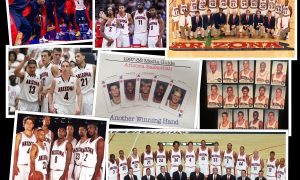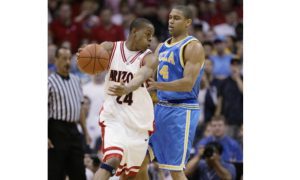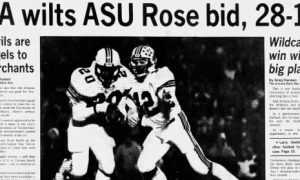|
|
|
ARIZONA PRODUCTIVITY RATING
[table “” not found /]
GLOSSARY:
G: Games played. S: Number of starts.
BP: Bench points. A player gets three points if he is first off the bench, two if second and one if third. Shows Sean Miller’s rotation.
UT: Productivity points against Washington
UMIN: Minutes played against Washington
PP: Productivity Points (Points, assists, rebounds, steals, blocked shots, FGs made, FTs made added together and then subtracted by missed FGs, missed FTs, personal fouls and turnovers)
TMIN: Minutes played overall
PR: Productivity rating per minute played (Productivity points divided by minutes played)
NOTE: Player must average at least 10 minutes a game to be listed in primary rotation
|
[table “” not found /] |
This is how it once was when I covered Arizona basketball during Lute Olson’s prime for The Arizona Daily Star: Which angle to cover in a game story? Jason Terry’s play off the bench? Mike Bibby’s impeccable shooting? Miles Simon’s ability to take over late in the game? Michael Dickerson shutting down an opponent while scoring 20 points on the other end? Arizona’s convincing 70-52 win over Washington last night at McKale Center was against a reeling Huskies team that has lost eight of their last 10 games, but that does not matter to Sean Miller. The Wildcats have beaten but struggled against suspect competition before — they swept Utah by only a combined seven points — so an 18-point victory over a team coached by Lorenzo Romar is nothing to sneeze at. This same Washington team almost beat UCLA at Pauley Pavilion two weeks ago, if it was not for a last-second jumper by Bruins guard Larry Drew II. How the Wildcats beat Washington is most important. Four of the Wildcats’ starters — Solomon Hill, Mark Lyons, Nick Johnson and Kaleb Tarczewski — were highly productive in the game. Hill posted 29 productivity points in 33 minutes to boost his team-leading productivity rating to .630 (for definition of productivity points and rating, see glossary). |
Lyons had 19 productivity points in 21 minutes, Johnson (mired in a slump entering the game) posted 17 productivity points in 32 minutes, and Tarczewski was most impressive (in my opinion) with 18 productivity points in 25 minutes.
Tarczewski, a 7-foot, 255-pound freshman, tied his career high with 10 points and pulled down eight rebounds in what was one of his best games of his young career. His defense was too much for Washington’s more experienced senior center Aziz N’Diaye (two points on 1-of-6 shooting and eight rebounds before fouling out). He also outplayed N’Diaye (7-foot, 260 pounds) in Seattle in Arizona’s 57-53 win on Jan. 31 with also 10 points and eight rebounds.
What must be encouraging to Miller is Tarczewski has mostly risen to the occasion. He had a career-high 13 rebounds in Arizona’s 69-50 victory over Miami (Fla.) on Dec. 23 in the Diamond Head Classic in Honolulu. The Hurricanes have one of the more experienced, physical frontcourts in college basketball.
“Big, young guys are more comfortable when they have an opportunity to play against a guy of their own size,” Miller said in the post-game press conference. “Where Kaleb has struggled this year is when he has to guard players away from the basket. He’s gotten better even in that area.
“That is going to be the challenge on Saturday when we play Washington State because they really spread you out. We have to do a really good job defending the three-point line.”
Washington State starts 6-10 frontcourt players D.J. Shelton and Brock Motum, both of whom attempted eight three-pointers and made only one in the Cougars’ 69-57 loss at ASU last night.
Brandon Ashley, now a reserve forward for the Wildcats, will likely be called on to play more minutes and defend either Shelton or Motum. That shows how resourceful and balanced the Wildcats can be for Miller. Ashley had another decent game off the bench, posting 17 productivity points in 20 minutes. Arizona’s top three productivity players this season are Hill, Lyons (.605 productivity rating) and Ashley (.603).

Brandon Ashley will be called upon more to defend Washington State frontcourt players Brock Motum and D.J. Shelton, who like to play on the perimeter
Tarczewski’s productivity rating stands at .462, which is a marked improvement from when Arizona lost 84-73 to UCLA on Jan. 24. He posted minus-2 productivity points in only 15 minutes against the Wear twins (Travis and David) to drop to a productivity rating of .397.
In the eight games since, Tarczewski has 101 productivity points in 164 minutes, a productivity rating of .616. His increase from .397 to .462 is the greatest productivity rating improvement in that period by any of the Wildcats. The only other player with an improved productivity rating in that span is Lyons from .595 to .605.
“I think all of the freshmen are trying to turn that corner,” Tarczewski told the media. “We’ve played so many games and we get more experienced towards our sophomore year.”
Miller is quoted as saying by The Arizona Daily Star’s Bruce Pascoe: “(Tarczewski’s) rebounding well, he’s moving well. One of the reasons Aziz fouled out was (Tarczewski) was on our team. We were able to get him the ball in scoring position and a number of times (N’Diaye) committed a foul against Kaleb.”
Behind Tarczewski, Hill (six rebounds), Ashley and Kevin Parrom (five each), Arizona also outrebounded the Huskies 43-37. Washington entered the game with the best rebounding margin (plus-5.3) in conference games.
“We outrebounded them by six and it shows you how physical we are,” Miller told Pascoe. “Angelo Chol is getting better, Kaleb is getting better, Grant (Jerrett) and Brandon are both able to give us great minutes. That size up from and the depth is something we have to take advantage of.”
Defensive Rebounding Percentage (DRB%): Determined by dividing Arizona’s defensive rebounds (33 against Washington) by the opposition’s offensive rebounds (Washington had 18) added to Arizona’s defensive rebounds (33) — 33/(18 + 33) = 64.7 percent.
Offensive Rebounding Percentage (ORB%): Determined by taking Arizona’s offensive rebound total (10) divided by that total (10) and the defensive rebounds of the opponent (19 for Washington) — 10/(10 + 19) = 34.5 percent.
Ideal marks are 72 percent DRB% and 38 percent ORB%.
|
DEFENSIVE/OFFENSIVE REBOUNDING% [table “” not found /] |
Site publisher, writer and editor Javier Morales is a former Arizona Press Club award winner
[rps-paypal]
|
|





























